Home Remedies for Unclogging Your Bathtub Drain
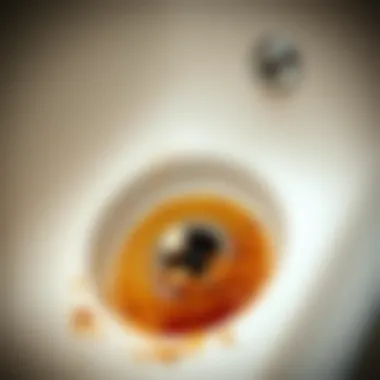
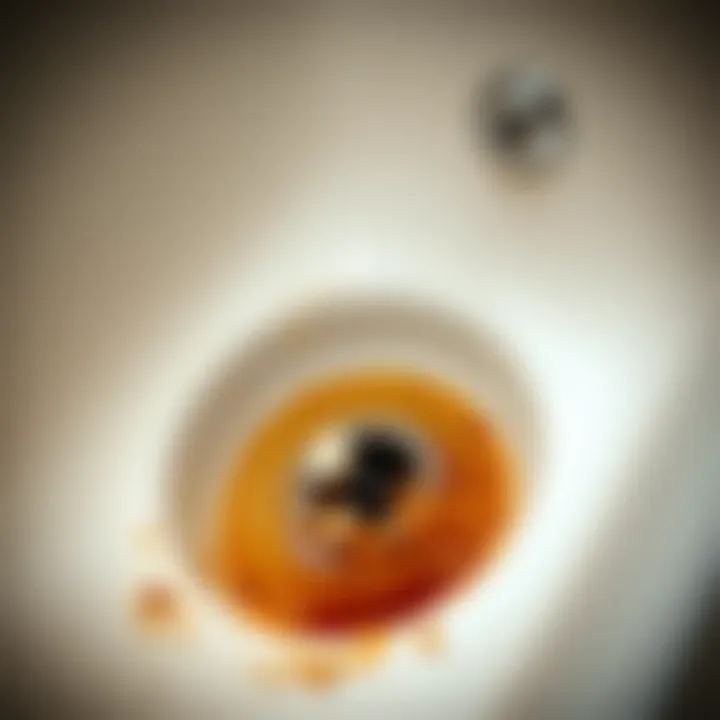
Intro
Bathtub drains can be a nuisance when they decide to play dead. A clogged tub doesn’t just dampen your mood; it can also lead to bigger plumbing headaches down the road. Understanding the ins and outs of unclogging your drain with home remedies is not just useful, it’s essential for every homeowner. In this guide, we’ll discuss effective strategies for tackling those stubborn clogs without rushing to the store for commercial products.
By diving into the causes of these clogs, you will grasp the nature of the problem. Further, we will explore a range of home remedies you can whip up with items sitting right under your nose! From baking soda to vinegar, simple solutions are often hiding in your pantry. Our aim here is not only to remedy the current situation but to equip you with the know-how to prevent these issues in the future.
Nobody enjoys standing in a pool of lukewarm water, so let’s cut to the chase and discover how you can maintain a clear and functioning bathtub drain without the fuss.
Understanding Bathtub Drain Clogs
Having a clogged bathtub drain is more than just an inconvenience; it can disrupt the entire bathing experience. Understanding the nature of these clogs is the first step in effectively addressing them. Knowing what leads to clogs not only helps you tackle the immediate issue but also serves as a foundation for better drain maintenance in the long run. Better awareness of this problem equips homeowners with knowledge to prevent future encounters, saving both time and potential repair costs.
Common Causes of Clogs
Clogs can stem from various sources, but some culprits pop up more frequently than others. Identifying these causes allows for targeted solutions.
Hair Accumulation
Hair is perhaps the poster child of bathtub clogs. Whether it’s from routine washing or shedding, hair tends to tangle and create a tight nest that blocks water flow. It’s a common sight to see dark strands stuck in the drain or coiling around the stopper. The key characteristic here is its fibrous nature, which can easily catch soap scum and other debris, turning it into a significant obstruction. Addressing hair clogs often proves beneficial; regular removal can drastically reduce the frequency of slow drainage.
Soap Scum Buildup
If hair accumulation is the villain, soap scum is the underling that's just as troublesome. As soap mixes with minerals in the water, it creates a residue that can cling to the walls of pipes. This milky film can build up over time, gradually narrowing the drain opening. The prevalence of soap scum in bathrooms, especially where hard water is an issue, makes it a significant consideration. Regular cleaning and using specific products designed to combat soap scum are advantageous tactics to consider in this article.
Foreign Objects
Sometimes, the enemy within the drain isn’t so obvious. Toys, cotton swabs, and even pieces of shampoo bottles can find their way into the drain. These foreign objects don't belong and can cause a blockage that’s challenging to remove. It’s crucial to be aware of what goes down the drain, especially in family homes where curious little hands might toss items without a thought. The unique feature here is unpredictability, making it vital to be vigilant about what enters the tub drain.
Mineral Deposits
In areas with hard water, mineral deposits can contribute to clogs over time. These deposits, primarily calcium and magnesium, settle in pipes and gradually reduce the drain's efficiency. Unlike hair or soap, mineral buildup is often slow and insidious, making it hard to notice until significant obstruction occurs. By understanding this particularity, one can implement routine maintenance to prevent severe problems from arising down the line, showcasing why a preventatively focused strategy is greatly advantageous.
Importance of Regular Drain Maintenance
While understanding clogs sets the stage, regular maintenance is the curtain call that keeps everything running smoothly. It’s essential to manage your drain proactively, rather than waiting for clogs to rear their ugly heads.
Preventative Maintenance Practices
Establishing a routine maintenance schedule is vital. Regular inspections and cleaning help keep minor issues from becoming larger problems. The unique feature of these practices is that they empower homeowners to take charge of their plumbing. Simple actions like flushing the drain with hot water once a week can do wonders for maintaining flow. It's a straightforward method that frequently goes overlooked yet proves incredibly effective.
Recognizing Early Signs of Clogs
Awareness is half the battle. Recognizing early signs of clogs, such as slow drainage or minor backups, can prevent a complete blockage. Highlighting this aspect emphasizes the importance of being attentive to your plumbing. If water begins to pool around the tub during a shower, it’s a call to action. Catching these signs early can save significant effort later on, as it demonstrates foresight in dealing with potential plumbing headaches.
Scheduling Professional Inspections
No one likes to admit it, but there are times when a professional's insight is invaluable. Scheduling regular inspections can ensure that any underlying issues are caught and addressed early. A professional can spot potential damage that you might miss. The advantage here is that investing in expert opinion can, at times, save substantial money in the long run by avoiding major repairs caused by neglecting minor issues. However, this choice should come after considering one’s financial situation and capacity for DIY solutions.
Initial Steps Before Applying Remedies
Before diving headfirst into home remedies for your clogged bathtub, it’s crucial to take a moment and appreciate the lay of the land. This preparatory phase sets the stage for an effective unclogging process. Even the most time-tested remedies can fall flat if applied without proper assessment or preparation. Ignoring these initial steps might waste effort and resources and could even exacerbate the problem.
Taking a step back to evaluate the situation helps make informed choices about what strategies to employ. Furthermore, understanding the severity of the clog and gathering the right tools can make the difference between smooth sailing and a plumbing nightmare. Let’s delve deeper into the initial steps before applying any remedies.
Assessing the Severity of the Clog
Visual Inspection Techniques
First up is the visual inspection. This method is often overlooked but is surprisingly effective. By taking a good look at your drain, you can identify common signs of trouble, like water pooling or visible debris. This technique requires no special skills, just your keen observation.
One of the key characteristics of this method is its straightforwardness. Often, we can see what’s blocking our drain merely by peeking down. If you spot hair or soap scum, you can directly address it using simpler methods. It’s worth noting that while the visual inspection can reveal surface-level issues, some clogs may lurk deeper, necessitating a different approach. However, this method is an essential first step as it gives you a clear idea of what you’re dealing with and skips excessive guesswork, saving time.
Water Level Indicators
Next, let’s talk about water level indicators. This isn’t as fancy as it sounds. Basically, just check the water level in the tub. If the water is slow to drain or is floating higher than normal, this instantly tells you there’s a blockage somewhere down the line.
The primary benefit of using water level indicators is their ability to provide immediate feedback. If you notice the water doesn’t budge at all, it's a telltale sign that the clog might be pretty serious. This method is straightforward but effective. However, this technique might not show you the exact nature of the blockage, which might require further investigation.
Utilizing a Plunger
A plunger is a classic tool that deserves mention here. Utilizing it can be a game changer. This method works on the principle of creating pressure to dislodge whatever it is that’s stuck in your drain.
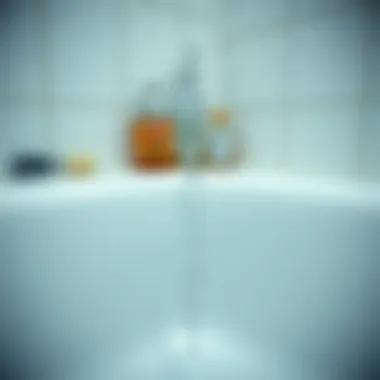
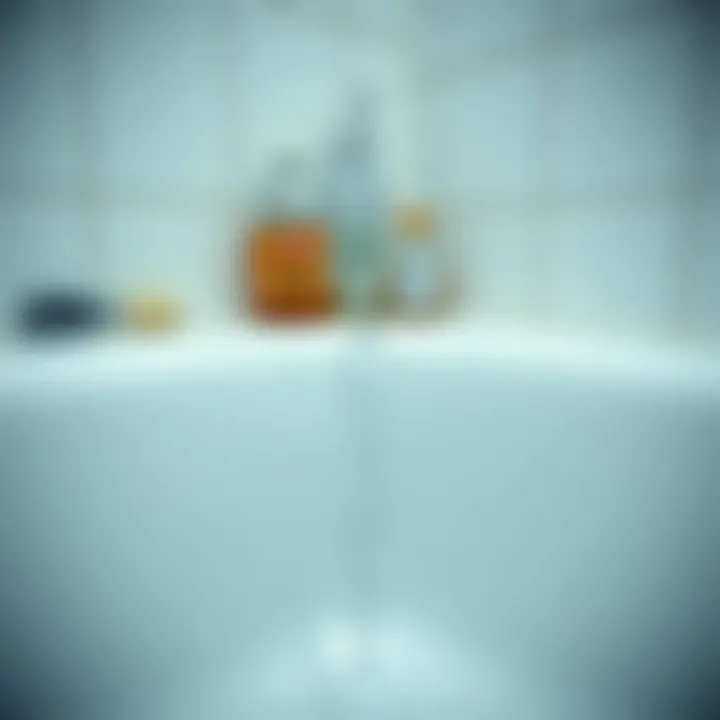
The key characteristic of a plunger is its versatility. It can work wonders on various types of clogs, whether they be hair, soap scum, or even a foreign object. However, there are some disadvantages to consider. Not all plungers are created equal, and using the wrong type might not yield the desired results. Also, if the clog is too deep, plunging might not help much, reinforcing the importance of initial assessment.
Gathering Necessary Tools and Materials
Once you’ve assessed the severity of the clog, it's time to gather your supplies. Having the right tools and materials at your disposal can significantly influence your success in unclogging the drain. Each tool has its specific contribution that enhances your ability to tackle the problem at hand.
Drain Snake
Let’s kick things off with the drain snake, a true ally in the battle against stubborn clogs. This tool is designed to reach deep into the plumbing and can latch onto or break apart blockages that are simply out of reach.
Its key characteristic lies in its flexibility and reach. With a drain snake, you can navigate bends in pipes that a plunger could never reach. However, it does require a basic understanding of how to use it effectively. Using a snake might pose some challenges if you're unfamiliar with plumbing mechanisms, but the reward is worth the effort. Clearing out deeper clogs can save time in the long run, preventing potentially costlier plumbing disasters.
Baking Soda and Vinegar
Baking soda and vinegar are classic staples in many households. This combination is not only effective but also incredibly eco-friendly. They are known to assist in breaking down blockages through a simple chemical reaction that produces fizzing.
The main advantage of using this method is its non-toxic nature, making it safe for the environment and your health. One downside, though, is that it may not always clear extremely stubborn clogs. Some folks find that while this method works wonders for minor issues, for thicker clogs, additional techniques might be required.
Boiling Water
Lastly, we have boiling water. This method might sound simple because, well, it literally is. Just boil a kettle and pour it down the drain. The heat helps to dissolve soap scum and grease that might be clogging the pipes.
The beauty of this method is its low-cost, yet highly effective nature. However, one must exercise caution when using boiling water, especially in plastic pipes, as extreme temperatures can cause damage. Weighing the risks and rewards plays a crucial role in deciding whether to use this technique.
Home Remedies for Unclogging a Bathtub Drain
Unclogging a bathtub drain can feel like digging a hole in the sand—it seems like a simple task, but there’s always the threat of sinking deeper into a mess. When faced with a frustrating clog, home remedies often prove not just cost-effective but also surprisingly effective. They offer a blend of simplicity, accessibility, and safety for homeowners looking to tackle minor plumbing issues without dialing a plumber or using harsh chemicals.
By opting for these remedies, you not only address the immediate problem but also take an important step toward more sustainable home maintenance. Many of us wish to cut down on chemical usage for health and environmental reasons, and these home remedies can help strike that balance.
Baking Soda and Vinegar Method
Preparing the Mixture
The dynamic duo of baking soda and vinegar is a go-to for many who want to unclog their bathtub drain. This method is valued for its natural ingredients—both baking soda and vinegar are pantry staples that can take on grime powerfully yet safely. When mixed, they create a reaction that produces fizzing bubbles—a sign of action in the works.
The best part about this mixture is that it’s a readily available solution, easily concocted without the need for special tools or expensive supplies. Just measure equal parts of baking soda and vinegar. It’s important to mix them and use the concoction right away; letting it sit dilutes its effectiveness. Not only is preparing this mixture simple, but it also invites the satisfaction of knowing you’re using items that are safe for your plumbing and the environment.
Application Process
Once you have your bubbly mixture ready, the application process is straightforward and essential for achieving results. Pour the baking soda into the drain first, followed swiftly by the vinegar. Be prepared for some fizz and foam, as this is where the magic happens. Cover the drain with a stopper—if you have one— to contain the reaction inside the pipe; letting it work its wonders undisturbed is key.
Leave it to do its job for about 30 minutes before rinsing with hot water. This method excels because it’s safe for your pipes, unlike some harsh chemicals which can cause damage over time. However, it may not clear more stubborn blockages completely, meaning multiple applications might be necessary or this remedy may need to be paired with another method.
Expected Outcomes
After completing this method, you'll want to evaluate how well your drain has responded. Ideally, the clog should loosen significantly, allowing water to flow freely. The bubbling action breaks down the hair, soap scum, and other debris build-up. For many, this method provides quick relief and positive results.
Yet, it’s essential to temper expectations. While this combination is powerful, it might not get rid of everything, especially if you're dealing with deep blockages or complex issues in your plumbing. The effectiveness here largely depends on the severity of the clog, making it a great first step but not necessarily a catch-all solution.
Boiling Water Technique
How to Execute Safely
Boiling water might sound overly simplistic, but don’t underestimate its power when it comes to unclogging drains. To execute this method safely, boil a pot of water and let it cool briefly before carefully pouring it down the drain. Why the wait? Pouring boiling water directly may cause damage, especially to older pipes made of plastic or rubber, so a little patience pays off.
The high temperature is key in softening any tough clogs that might be sticking to the sides of the pipes. It's important to note, however, that while this can work wonders on minor blockages caused by soap scum or debris, it might not be effective against foreign objects or significant build-up.
For a successful execution, consider pouring the boiling water in stages; allowing the water to sit for a moment between pours can help to push through more stubborn obstacles. Remember, safety first—use an oven mitt or pot holder to prevent burns.
Multilevel Drain De-clogging
Sometimes, a drain clog is not just a simple affair but a multi-layered event involving different points within the plumbing system. This is where the boiling water technique can shine, providing a wide-spread effect to multiple spots. Pouring boiling water gradually down the various fixtures drains, particularly if they share a common pipe, can help tackle clogs lying deeper in the system.
What makes this method valuable here is its systemic approach, managing multiple issues at once without needing multiple treatments for different locations. However, like all methods, caution is crucial to avoid overwhelming any vulnerable pipes.
Effectiveness of Temperature
Hot water serves a dual purpose in this context: it not only helps melt away gunk but can also create movement in the drain. Warm water revitalizes the inertia of the water already present, pushing clogs along rather than just sitting stagnant. It’s advantageous to alternate between hot and cold cycles, as certain debris may respond better to changes in temperature.
While effective, it’s worth noting that the temperature needs careful management; too hot can lead to issues, especially in aged systems. If your plumbing is newer, though, you might find hot water's effectiveness to be a reliable and easy option when you face minor clogging issues.
Salt and Baking Soda Solution
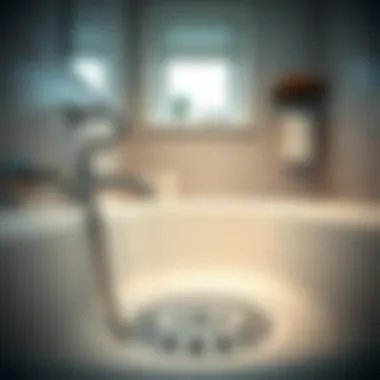
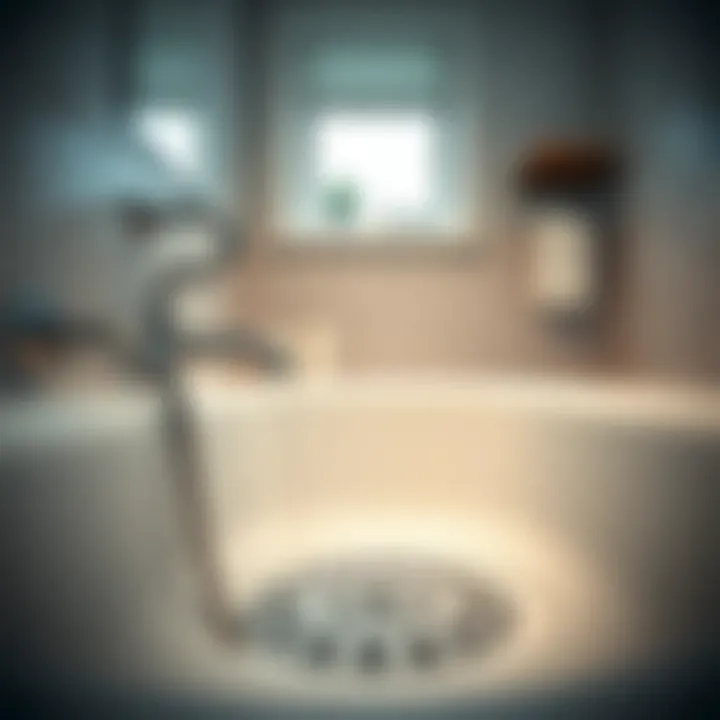
Mixing Proportions
Using salt combined with baking soda creates another solid home remedy for unclogging a bathtub drain. The usual proportions involve roughly -- One part salt to two parts baking soda. This combination harnesses the abrasive quality of salt alongside the alkaline nature of baking soda, resulting in a powerful solution for breakin up clogs. Salt can act as a gentle scrubber, while baking soda works to dissolve the materials.
The mixing is straightforward, making it a desirable choice for many enthusiastic DIY-ers. Remember, too much salt can be counter-productive, and following the recommended proportions is key here.
Method of Application
To apply this salt and baking soda solution effectively, it is best to prepare the dry mix and pour it directly into the drain. Follow this with warm water that will help activate the blend's properties. After applying, let it sit for about 15 to 30 minutes—this waiting period allows the solution to penetrate the clog efficiently.
This method has garnered popularity because it invokes natural ingredients, making it a healthier alternative to caustic chemical cleaners. However, stubborn clogs may not respond well to this remedy and might require reinforcements from other techniques.
Post-application Cleanup
After the method has worked its magic, the post-application cleanup is critically important. Carefully flush the drain with hot water to clear away any remaining residue from the mixture. You might need to run the water for a few minutes to ensure that the path is completely clear.
It’s essential to ensure that you properly cleanup any leftover mixture to avoid it hardening and causing its own obstruction. This aftercare not only maintains the drain’s health but also keeps your plumbing in good running order.
Using a Drain Snake
Selecting the Right Drain Snake
When all else fails, a drain snake may just be your best friend. It allows you to tackle clogs that are positioned deep within your plumbing system. When selecting a drain snake, look for one that is appropriate for bathtub drains; this often means a flexible cable design that can maneuver bends in the piping. A model designed specifically for home use typically provides ease of handling.
The important thing about selecting a drain snake is ensuring that it’s long enough to reach potential blockages deeper in the line while being light enough for easy maneuverability. While store brands can serve, don’t hesitate to go for higher quality options if you anticipate future clogs; this equipment can be used multiple times.
Techniques for Effective Use
Using a drain snake effectively requires some technique. First, insert the snake gently into the drain, turning as necessary to navigate the curves of the pipe. Once you hit resistance, continue rotating the handle to grab or break through the clog. Pull back slowly, making sure not to disturb other areas of the drain unnecessarily. This step takes some practice but can be quite effective.
Having a little patience here is key; forcing the snake can damage pipes, so go slow, steady, and maintain a gentle hand. Learning to properly use a drain snake adds a valuable tool to your home maintenance toolkit, especially if you're frequently battling clogs.
Clearing Deeper Clogs
Dealing with deeper clogs can be a challenge; however, the drain snake is specifically designed to reach those problem areas. If the initial pull reveals little progress, you can sometimes go in with additional turns or a more aggressive approach to break up whatever material is causing the blockage.
Nonetheless, this is where caution is vital. If you feel significant resistance, backing off is advisable to prevent harming the plumbing or getting the snake stuck itself. Weighing the risks versus rewards here plays a pivotal role, as sometimes deeper issues require more skilled intervention.
Ultimately, using a drain snake gives homeowners the upper hand when confronting drainage issues, especially when other home remedies don’t do the trick.
Preventative Measures to Avoid Future Clogs
Taking preventive action is essential when it comes to avoiding bathtub drain clogs. Implementing specific strategies can save you time, money, and those frustrating late-night situations where water doesn’t go down as it should. Not having to deal with the inconvenience of a clogged drain means there’s one less thing on your plate, which is always a good thing.
Regular Cleaning Routines
Establishing a Schedule
Establishing a cleaning schedule is vital in maintaining a smooth-flowing drain. Consistent cleaning is like a well-oiled machine; it keeps everything running efficiently. The key characteristic of setting up a schedule is that it gives structure to your cleaning efforts. Regular cleaning helps catch minor build-ups before they morph into full-blown clogs.
Setting aside time each month or every couple of weeks can be a very good choice for actively avoiding issues. Unexpected fullness can be a thing of the past, allowing you peace of mind. The unique feature of a schedule is its ability to align with your lifestyle. For example, if you have a busy household with kids and pets, cleaning more frequently could be sensible. Conversely, a quieter home might mean stretching that cleaning out a bit. While a thorough cleaning might take a bit of effort, it generally pays off in the long run.
Choosing Appropriate Cleaning Products
Choosing appropriate cleaning products can significantly affect how well you can maintain your bathtub drain. This aspect contributes to keeping your plumbing in top shape. The right product can break down hair and soap scum effectively without causing harm to your pipes.
Using natural or enzymatic cleaners is a popular choice these days. These options are not just environmentally friendly but also gentle on your plumbing system. Generally, they break down build-ups without harsh chemicals that can damage pipes over time. However, you should also pay attention to the unique feature of your tub material. For instance, stronger chemicals might be suitable for metal but could harm plastic or acrylic tubs.
Deep Cleaning Techniques
Deep cleaning techniques can truly open your eyes to how much better your bathtub can perform. When you dive into deep cleaning, you ensure that nothing is hanging around that could lead to future issues. This helps keep the drains clear of gunk, and you can spot early signs of trouble.
One effective method is to use a mixture of baking soda and vinegar, allowing it to sit, and later flushing it with hot water. This procedure isn’t just beneficial in cleaning; it also gives you a chance to evaluate how well your drain is functioning overall. Regularly employing deep cleaning can circumvent the hassle of clogged drains. While it might take a bit more elbow grease than standard cleaning, the long-term benefits usually outweigh the effort.
Installing Drain Strainers
While keeping things clean is crucial, proactive measures like installing drain strainers can further safeguard against future clogs. Strainers act as the first line of defense, catching hair and debris that might slide down the drain inevitably.
Benefits of Using Strainers
One significant benefit of using strainers is preventing large particles from entering your plumbing system. They can very effectively trap hair and soap remnants right where they start to form clogs. The key characteristic of a strainer is its simplicity; it doesn’t require any complicated installation and can usually be placed or removed easily.
Alongside ease of use, strainers also promote better hygiene, as they limit what can accumulate in your drain. A drain that has a strainer is less likely to host foul odors as debris won’t get a chance to sit and rot.
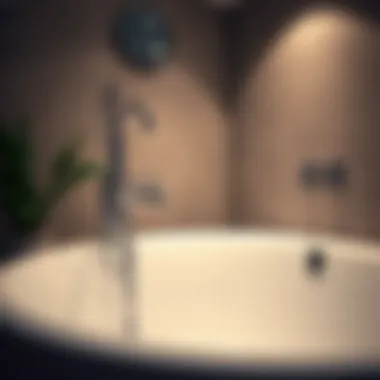
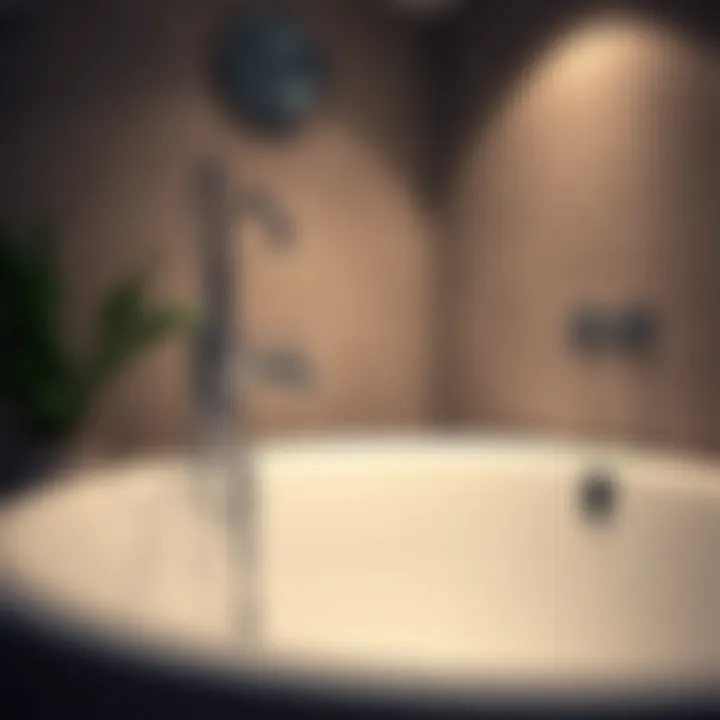
Choosing the Right Strainer for Your Tub
Choosing the right strainer for your tub is essential for achieving maximum efficiency. This means considering various factors, like the drain size and the design of your tub. A drain strainer that fits snugly can trap hair effectively without letting anything slip through the cracks.
You often find mesh strainers, which are great at preventing both hair and debris from entering the drain. However, fancy decorative strainers might not function as well; they may look nice but could leave you with clogged pipes. Think about the unique features of your chosen strainer type. While a well-fitted strainer works wonders, a poorly fitting option may show itself as a double-edged sword.
Maintenance of Strainers
Maintaining strainers is often overlooked, but keeping them clean and free from build-ups ensures they function optimally. The characteristic that makes regular maintenance key is that it prevents the strainer itself from becoming a source of clogs.
Cleaning strainers on a regular basis is simple and can usually be done by rinsing them under hot water to remove trapped debris. Once a week or as needed is a decent benchmark for how often to check them. A unique feature of maintaining strainers is the peace of mind they bring. With clean strainers, you can confidently know that you’re not providing the perfect environment for clogs to start.
When to Seek Professional Help
Handling bathtub drain clogs can often seem like a simple task, easily tackled with a few home remedies. However, there are times when it is wiser to wave the white flag and call in the professionals. Understanding when to seek expert help can save you time, money, and avoid further damage to your plumbing.
Signs Indicating Professional Intervention
Repeated Clogging
Experiencing repeated clogs is a signal that something is amiss. It's common to encounter a clogged drain every now and then, but if it becomes a recurring problem, it likely indicates a deeper issue in the plumbing system.
One key characteristic of repeated clogs is the frustration it brings to daily activities like showering or bathing. Not only does it disrupt your routine, it can lead to more significant problems, if left unaddressed. Ignoring the issue can result in more serious blockages or even pipe damage. In this case, consulting with a professional can pinpoint the exact cause—be it tree roots infiltrating the pipes or buildup from years of neglect.
Slow Drainage
Slow drainage isn't just an inconvenience; it's a clear indicator that your plumbing systems are under duress. Water pooling in the tub while you shower is not just annoying; it tells you that something isn’t functioning as it should. This could stem from minor build-up or a more serious underlying issue.
The hallmark of slow drainage is the gradual buildup of water, often leaving behind soap scum or residue. This situation’s unique feature is that it often worsens over time, challenging the effectiveness of home remedies. When the drain struggles day after day, it might be wise to consult a professional plumbing service to evaluate the situation properly.
Odors and Backups
Unpleasant odors and sewage backups represent a multi-faceted concern. These signs suggest that not only is the drain clogged, but there could be a serious issue with the sewage line or other plumbing components. Odors can arise from decomposing materials stuck in the drain system, creating a health hazard alongside the nuisance.
The significance of dealing with these odors and backups cannot be understated. Ignoring them can lead to further complications, including flooding or structural damage in the home. The unique feature of identifying such issues early is that it allows for timely intervention, potentially saving you from expensive repairs later on.
Choosing the Right Plumbing Service
When it's time to call the pros, knowing how to choose the right plumbing service can make all the difference. You don't want to end up with a service that doesn’t meet your expectations.
Researching Credentials
Researching a plumbing service’s credentials is paramount. This entails examining how long they’ve been in operation, what licenses they hold, and whether they have the required insurance. Knowing a service is licensed and insured provides peace of mind in case complications arise during the job.
The primary characteristic often sought is reputation. A well-reviewed plumbing service comes with the confidence that they can tackle a variety of drain issues. Be sure to check if they’re recognized by any professional plumbing organizations, which can affirm their credibility.
Evaluating Customer Reviews
Evaluating customer reviews offers a glimpse into the experiences of previous clients. It helps in understanding how a company treats its customers, responds to complaints, and delivers on promises. Consistency in service, as noted by multiple positive reviews, is a strong signal of reliability.
Review platforms or social media can provide insight into common issues faced by clients. A plumbing service that consistently receives praise for responsiveness and professionalism usually marks itself as a good contender. Conversely, numerous complaints might indicate trouble lurking beneath the surface.
Understanding Pricing Structures
Understanding the pricing structure is vital before committing to a plumbing service. This includes knowing how they charge—whether flat fees or hourly rates—along with any potential additional costs. Transparent pricing leads to fewer surprises and allows you to budget your expenses accurately.
What you should look for is clarity and fairness in their pricing models. A reputable plumbing service will provide detailed estimates and clarify included and excluded services. Some companies may upsell, which can lead to distrust; therefore, knowing the pricing structure upfront establishes a more trustworthy relationship.
It’s essential to know when to call in the professionals. Addressing plumbing issues might seem daunting, but timely intervention can save heaps of trouble down the line.
Epilogue
In summary, understanding and applying effective strategies for unclogging a bathtub drain can save homeowners both time and money. This article has outlined various home remedies that are not only affordable but also simple to implement. When faced with a clogged drain, utilizing baking soda and vinegar, boiling water, or a salt and baking soda solution can provide quick relief without the need for harsh chemicals or expensive plumbing services.
Summary of Effective Methods
Each method discussed offers unique benefits:
- Baking Soda and Vinegar: Engages in a fizzy reaction that can break down small clogs effectively. It’s environmentally friendly and leaves pipes clean.
- Boiling Water: A no-nonsense approach that can dissolve soap scum and grease quickly. Just be cautious with plastic pipes, as extreme heat may cause damage.
- Salt and Baking Soda: An abrasive agent that scrubs through tough clogs; its properties also deter future buildup.
- Drain Snake: The heavy artillery for serious clogs, providing mechanical assistance to clear out debris that other methods may miss.
Using these techniques not only addresses current issues but educates homeowners to understand their plumbing better.
Encouragement for Better Drain Maintenance
Maintaining a clear bathtub drain should not feel like a chore. Setting up a regular cleaning routine can make this task manageable and even effortless. Consider incorporating the following practices:
- Routine Inspections: Periodically check for hair accumulation or buildup. Early detection can prevent larger problems.
- Use Drain Strainers: They catch debris before it gets into the pipes, stopping clogs in their tracks. Invest in high-quality strainers that are easy to clean.
- Educate Family Members: Ensure everyone in the household knows what should and shouldn't go down the drain.
"Prevention is better than cure" holds true, especially in plumbing.







